The direct quotes in this story are from a taped interview of my mother, Katy, when she was 75 years old. The tape and transcript of her voice is a priceless treasure to her family.
“When I was really little, sometimes I would go out back behind the house where there was a little hidden corner and I would just lie down in the dirt and go to sleep in the sun. My toys were stones and sticks. I used to crawl around in the dirt and make roads and build houses with rocks, and little twigs. I lined up small stones for fences. Dirt clods would be the cows.”
The life of a child in the 1930s was obviously very different from a child’s life today. The children of more affluent families played with toy trucks and airplanes, teddy bears, pedal cars, train sets, bats and balls. They had bicycles, roller skates, rocking horses and red wagons. Much of their time was spent outdoors getting lots of exercise. Indoors, they listened to radio programs like Little Orphan Annie, Buck Rogers, Dick Tracy, Lone Ranger. The most popular books then were Nancy Drew Mysteries, The Hardy Boys, and the Oz books.
During the Great Depression, though, millions of children and their families lived in poverty and had very little to eat. There was never money to spare for toys and entertainment. For those who lived on farms, the greatest form of entertainment was their own imagination.
“Us kids didn’t have many toys, really, but we invented our own silly games. My youngest brother and I when we were five and six would run around the dining room table in circles like a game of tag. I would flip the crocheted lace of the table cloth up onto the table top and he would run behind me and flip it down. Silly stuff like that, but it was a way of having fun, you know.”
Kids used whatever was lying around to create their own games and toys at home. Girls made rag dolls, boys made kites or carved toys from wood. They played school yard games like tag, red rover, dodge ball, marbles and jump rope. Most kids had a ball and they may have had ice skates or a wooden sled.
“I did have a little family of dolls in my bedroom. They sat in the rocking chair. They weren’t fancy dolls or anything, Their heads were carved out of wood, with the hair and face painted on. They were all different sizes. I had a doll cradle, too. Every year at Christmas I would get the same cradle over and over again, but painted a new color and the dolls would all have new dresses that my mother made.”
“I was such a daydreamer. One time I remember running around in a field chasing dried thistles blowing in the wind pretending I was a fairy, and I ran into barbed wire. I still have a scar on my wrist.”
“When I was a little older, I would just go out walking with my friend, Wilma, for fun. She lived on the next farm. At night, when the moon was out we would walk the dirt roads together and sing. We practiced harmonies. Wilma and I and her sister Pearl did a lot of sewing, together, too, and we would pin curl each others’ hair. Wilma would come to our house a lot, and to this day I can see her eating the bread my mother baked. She said it was the best bread in the world. But she didn’t have a mother, so I don’t know what kind of bread they were eating over there at her house.”
“We had a horse called Kate – a working horse, not a pet. I loved old Kate. I rode her bareback, because we didn’t have saddles. I would ride her out to the field and put the cows out to graze. I had to stay with them so they wouldn’t wander off because it wasn’t fenced in. I lay down in the grass and read romance magazines. I’d take a lunch with me and stay all day. Those were the good days, I tell you, when I was young. I lay down in the tall grass and watched the clouds and the bugs . I watched the cattle and it was my favorite chore.”
As children became teenagers in the 1930s, there were movie theaters for their entertainment if they lived in town, and soda shops, school dances, church functions, and libraries. Teenagers on the farms were left out, especially the girls.
“There was a movie theater in Esmond, but as teenagers, only my three older brothers were allowed to go into town. One time two of my brothers and I did get permission to go to a church bazaar in town but we had to go back home to milk the cows. A young man came home with us. He helped us milk and he squirted me with the milk to get my attention. I liked him. Then we went back to the bazaar to attend the dance. My dad was drunk and he came out on the dance floor yelling, and dragged me out. He really made a scene calling me names. He was such a terrible person. That boy did not know what to think. I don’t guess I ever saw him again.”
“Dora Rowland, a neighbor lady, taught me every thing I needed to know as a teenage girl. I took care of her baby, Gordon, and she gave me permanent waves. She would curl my hair for me before big school doings. She taught me about using deodorant. She got me a little white jar of Mum. It had a red lid. I always used it before going to church.”
“I wore awful hand-me-down clothing., but every once in a while my Aunt Barbara would send me things in the mail from Washington – bracelets and clothes and stuff. She sent me a baby-blue quilted satin bed jacket which was so beautiful, I wore it to church. After church, Wilma told me it was a bed jacket. I never even heard of bed jackets. I remember Aunt Barbara sent me rust-colored wool slacks that I though were so cool. Anything she sent me I loved, even though they were all hand-me downs. She sent me a sheer pink fancy dress once that came down to my ankles. It had satin stripes around the skirt. I have some photos of me wearing that dress. My two girlfriends always wanted to try it on and they had their pictures taken in that dress, too.”
“Oh! And after a while, we got an old radio. We listened to Stella Dallas, Our Gal Sunday, The Shadow, Gangbusters – some real good radio programs. It took a long time for us to get a radio. You know, we were pretty poor. There wasn’t money for luxuries like radios and stuff. I remember the first one we got, a big funny looking old radio that stood in the dining room. My brothers went out and put up an aerial on top of the house. ”
To have these particular childhood memories from my mother is such a joy to me. She told me so many stories about her young life in the 1920s and 1930s, and most of them, I have to say, were sad, sorry tales. I was always so grateful whenever she found happy memories to share with me. Memories like these.



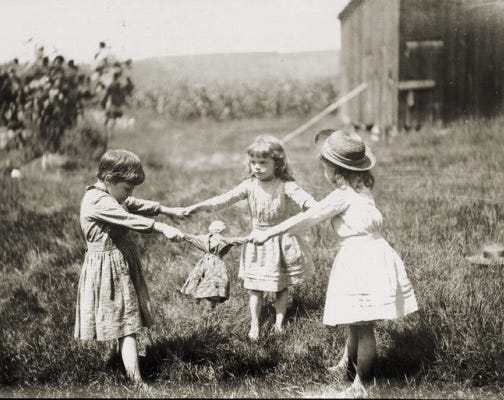
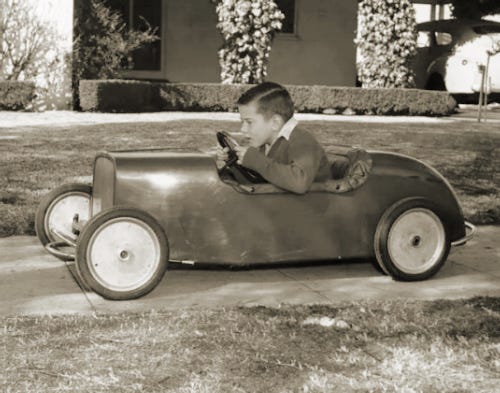

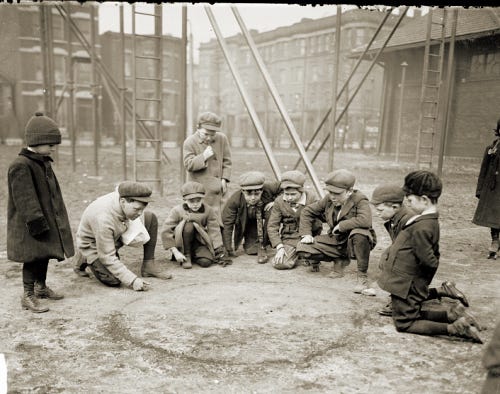

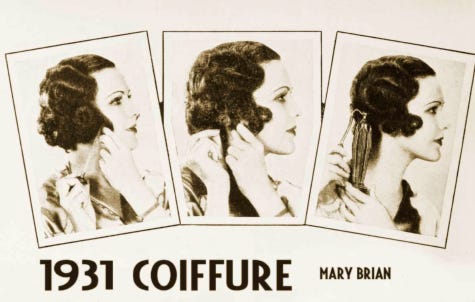
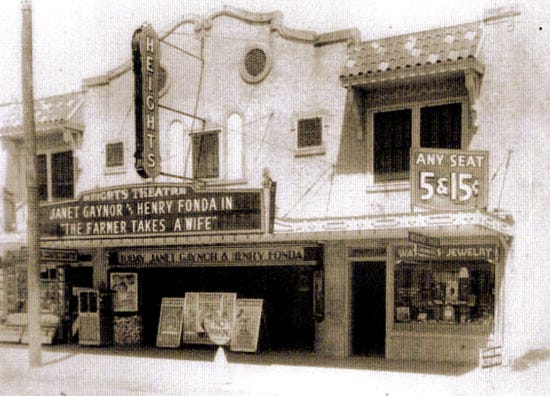
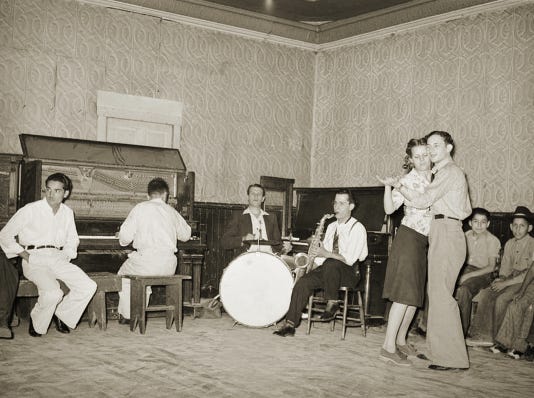

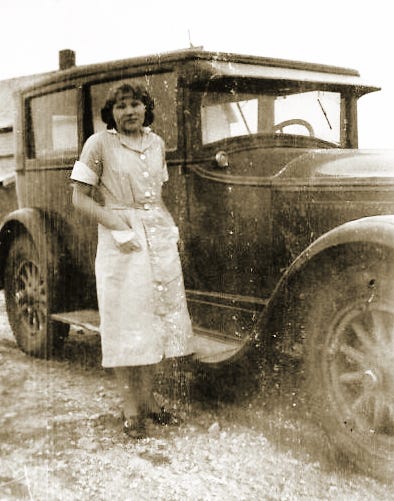
I'm glad she had some happy memories in between all her hardships.
Your Mom was a wonder. I'm sorry I didn't get to meet her....2000 miles distance can be a nuisance. I grew up in Chicago when most of the street was still empty of houses. They filled in by high school. My sister and I played in the big empty lot beside our house, climbing the big dirt hill. I"m glad to live in the country now.... just the opposite of your Mom's life. Another Kate.